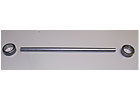
Not surprisingly, given the many steps involved, this was an unwieldy and expensive process. For example, the rings and rod themselves were costly. In addition, to obtain the needed precision, the stamped rings required secondary machining to tight tolerances, while the length and the tip diameters of the rod had to be held to specific dimensional requirements after welding. Plating and shipping charges increased the piece price even more.
To reduce these costs, ZF Lemforder’s manufacturing engineers decided to die-cast the rings directly onto the rods using a zinc alloy process from the FisherTech division of FisherCast Global Corp. (Peterborough, Ontario). Among other benefits, the process could be made to work by integrating a single automated injected metal assembly (IMA) system into ZF Lemforder’s existing production line. The equipment’s method of die-casting the rings directly on the rods also eliminated critical component preparation, secondary machining and plating of the completed assembly.
With the IMA process, the rod length is not critical, which reduces component cost, because tolerance control is now made possible by the precision die-casting tool, which forms the zinc alloy ring directly onto the knurled ends. Specifically, the ring is cast to ±0.03 millimeter, but the overall length tolerance of the rod need only be ±1 millimeter. During processing, the rod is held in a precise position in the tool in relation to the outside diameter of the ring, and the molten alloy flowing around the end compensates for any inconsistency.
In addition, ZF Lemforder can perform this operation using a preplated rod. This further improves productivity, because the company no longer has to ship each completed assembly out for plating, allowing same-day production of the stabilizer link.
“Before we had to wait days for parts to return from plating. We also save on the amount of plating being applied, as it is only required on the rods,” says ZF senior manufacturing engineer John Belding. “The zinc material is…less expensive than the stamped steel ring, and the cost of casting is equivalent to the welding operation. The tool design ensures the very tight tolerances required for the rings…. FisherTech’s hot chamber die-casting process consistently maintains these tolerances from part-to-part with no secondary finishing.”
According to Belding, yet another advantage to the new method is that it allows ZF Lemforder to incorporate a detail inside the bore for ease of assembly and retention of inserted components. It also makes it possible to change the date stamping of the die-cast rings on a weekly basis. Overall, Belding says the zinc-alloy die-cast rings exhibit very favorable strength, dimensional stability and load-bearing characteristics, as the alloy has mechanical properties similar to low carbon steel.
FisherCast custom designed ZF Lemforder’s IMA machine and tooling, which includes robotic automation for flexibility and to ensure quality. An integrated vision system checks rod dimension and presence of the knurl before the robotic arm places a rod in each of the two ring-shaped cavities in the die-casting tool. As the zinc alloy solidifies, it locks securely onto the knurls. The assembly is removed, the runner trimmed from the ring, and the second end introduced to the tool cavity for die-casting.
The system is highly flexible and easily adaptable to changes in the die-cast configuration and rod length. Inserts can be use in the existing tool to create different ring sizes.
For more on IMA technology and its use in assembly, call 866-536-2278 or visitwww.fishercast.com.